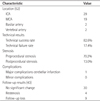Abstract
Purpose
We evaluated the usefulness of intracranial stent implantation for treatment of drug resistant atherosclerotic stenoses.
Materials and Methods
Between March 2004 and July 2007, we tried intracranial stent implantation in 49 patients with 52 lesions (anterior circulation 48 cases, posterior circulation 4 cases) who had an ischemic stroke with more than 50% of major cerebral artery stenosis. We classified the lesions by their location and morphology, analyzed the results in terms of the success rate, complication rate, and restenosis rate during the follow-up period.
Results
Intracranial stent implantation was performed successfully in 43 cases (82.7%). In eight of the nine cases, the stent implantation failure was due to the tortuosity of the target vessel. There was no major periprocedural complication. One patient showed cerebellar infarction after the procedure. Mean residual stenoses decreased from 70.2% to 13.0%. Four cases (9.3%) demonstrated in-stent restenoses and more than 50% during the mean and 25.3/month after the follow-up period.
Figures and Tables
Fig. 1
64 years old man who presented right side weakness and dysarthria.
A, B. Angiography shows 66% stenosis (arrows) at M1 segment of left MCA.
C, D. After inserted stent (arrows) above the lesion, angiography shows improved blood flow.
E. Follow up after 38 months, MRA shows no significant abnormality.
Note.-MCA = middle cerebral artery, MRA = magnetic resonance angiography

Fig. 2
55 years old woman who presented motor weakness and sensory change.
A. Diffusion weighted and Perfusion MRI shows left frontal lobe infarct and decreased blood flow in the left ACA territory.
B. Angiography shows long segmental severe (73%) stenosis (arrow) at supraclinoid portion of left ICA.
C. After balloon angioplasty and stent (arrow) insertion, blood flow was improved.
D. Follow up after 6 months, angiography shows restenosis (arrow) in stent.
Note.-ACA = anterior cerebral artery, ICA = internal carotid artery

Notes
The authors express their gratitude to Gyung Kyu Lee, M.D., Department of Radiology, Hangang Sacred Heart Hospital, Seoul, Korea, Hey Sil Jang, Department of Administration., Myungji Saint Mary's Hospital, Seoul, Korea, Shiyi Lui, M.D., Intervention treatment center, Shanghai Saint Luke's Hospital, China, Tong Lin, M.D., Department of Emergency, Shanghai Saint Luke's Hospital, China, Tongfu Yu, M.D., Department of Radiology, Jiangsu Province Hospital, Nanjing Medical University, China, for their data analysis.
References
1. Kim JS. Stroke in Korea. Int Congr Ser. 2004; 1262:348–351.
2. Suh DC, Lee SH, Kim KR, Park ST, Lim SM, Kim SJ, et al. Pattern of atherosclerotic carotid stenosis in Korean patients with stroke: different involvement of intracranial versus extracranial vessels. AJNR Am J Neuroradiol. 2003; 24:239–244.
3. Lylyk P, Cohen JE, Ceratto R, Ferrario A, Miranda C. Angioplasty and stent placement in intracranial atherosclerotic stenoses and dissections. AJNR Am J Neuroradiol. 2002; 23:430–436.
4. Groschel K, Schnaudigel S, Pilgram SM, Wasser K, Kastrup A. A systematic review on outcome after stenting for intracranial atherosclerosis. Stroke. 2009; 40:e340–e347.
5. Choi HW, Koo YB, Lee TH, Kim HJ, Lee JW, Kim CW, et al. New Techniques for Intracranial Stent Navigation in Patients with Tortuous Arteries. J Korean Radiol Soc. 2005; 52:101–106.
6. Suh DC, Kim JK, Choi JW, Choi BS, Pyun HW, Choi YJ, et al. Intracranial stenting of severe symptomatic intracranial stenosis: results of 100 consecutive patients. AJNR Am J Neuroradiol. 2008; 29:781–785.
7. Bogousslavsky J, Barnett HJ, Fox AJ, Hachinski VC, Taylor W. . Atherosclerotic disease of the middle cerebral artery. Stroke. 1986; 17:1112–1120.
8. Failure of extracranial-intracranial arterial bypass to reduce the risk of ischemic stroke. Results of an international randomized trial. The EC/IC Bypass Study Group. N Engl J Med. 1985; 313:1191–1200.
9. Chimowitz MI, Kokkinos J, Strong J, Brown MB, Levine SR, Silliman S, et al. The Warfarin-Aspirin Symptomatic Intracranial Disease Study. Neurology. 1995; 45:1488–1493.
10. Thijs VN, Albers GW. Symptomatic intracranial atherosclerosis: outcome of patients who fail antithrombotic therapy. Neurology. 2000; 55:490–497.
11. Mazighi M, Tanasescu R, Ducrocq X, Vicaut E, Bracard S, Houdart E, et al. Prospective study of symptomatic atherothrombotic intracranial stenoses: the GESICA study. Neurology. 2006; 66:1187–1191.
12. Siddiq F, Vazquez G, Memon MZ, Suri MF, Taylor RA, Wojak JC, et al. Comparison of primary angioplasty with stent placement for treating symptomatic intracranial atherosclerotic diseases: a multicenter study. Stroke. 2008; 39:2505–2510.
13. Marks MP, Marcellus ML, Do HM, Schraedley-Desmond PK, Steinberg GK, Tong DC, et al. Intracranial angioplasty without stenting for symptomatic atherosclerotic stenosis: long-term follow-up. AJNR Am J Neuroradiol. 2005; 26:525–530.
14. Lylyk P, Ferrario A, Pasbon B, Miranda C, Doroszuk G. Buenos Aires experience with the Neuroform self-expanding stent for the treatment of intracranial aneurysms. J Neurosurg. 2005; 102:235–241.
15. Marks MP, Marcellus M, Norbash AM, Steinberg GK, Tong D, Albers GW. Outcome of angioplasty for atherosclerotic intracranial stenosis. Stroke. 1999; 30:1065–1069.




 PDF
PDF ePub
ePub Citation
Citation Print
Print



 XML Download
XML Download